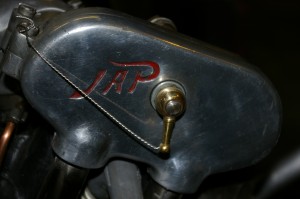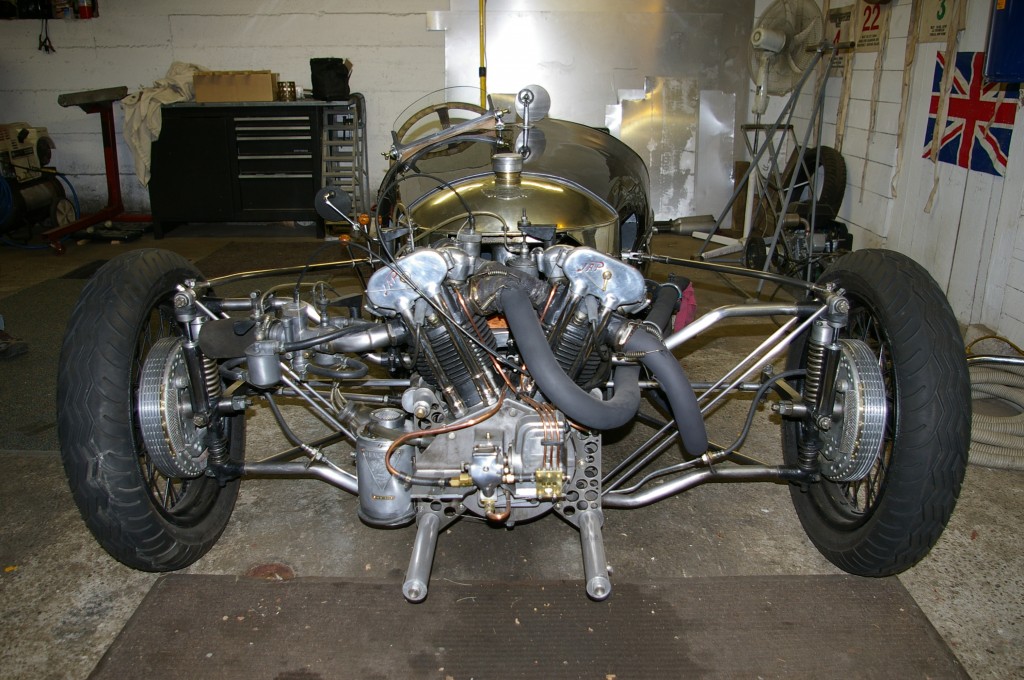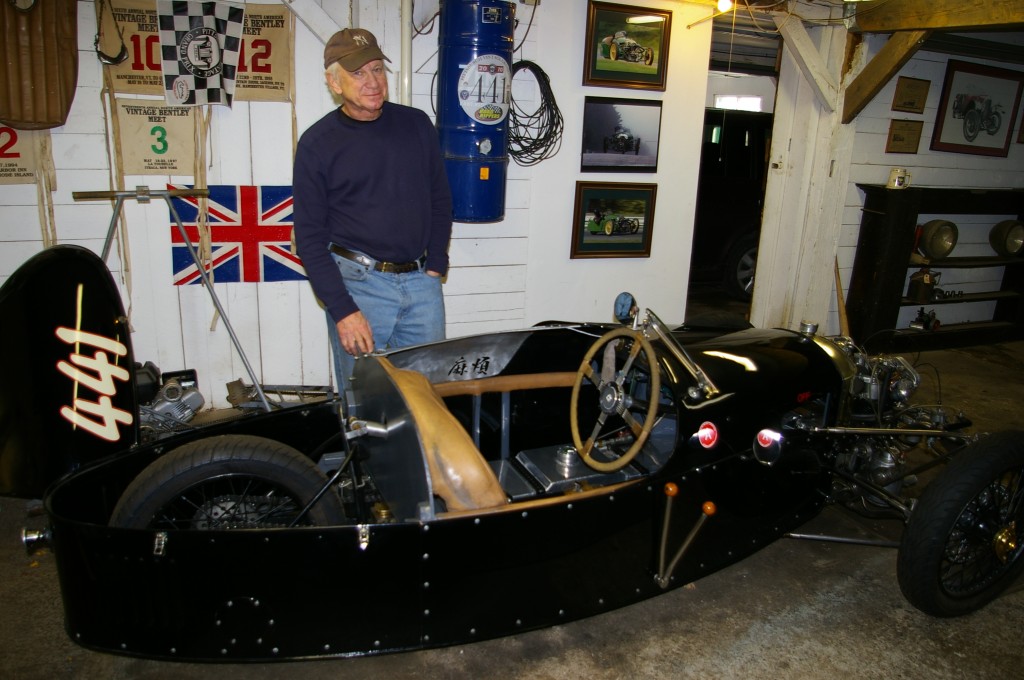By Bud Wilkinson of RIDE-CT.com
Not all motorcycles have V-twin motors. There are single-cylinder “thumpers,” triples and inline fours. And not all V- twin motors are found in motorcycles. From spring to fall, I spend two to three hours each weekday morning atop a vibrating V-twin lawnmower cutting greens for fun and profit at Fairview Farm Golf Course in Harwinton. But a car powered by a V-twin?
twin motors are found in motorcycles. From spring to fall, I spend two to three hours each weekday morning atop a vibrating V-twin lawnmower cutting greens for fun and profit at Fairview Farm Golf Course in Harwinton. But a car powered by a V-twin?
Jeff Jacobson of Cornwall owns one and races it at Lime Rock Park. It’s a three-wheeled 1931 Morgan Super Aero with a J.A.P. engine mounted sideways between the two front wheels. Just like a motorcycle, it has a chain drive that propels a single rear wheel. Putting out more than 100 horsepower, Jacobson’s right-hand drive Morgan is capable of speeds in excess of 110 miles per hour.
What made me think of Jacobson was a recent announcement by the British car builder that it’s bringing back a three-wheeled vehicle. Morgan began making its original Threewheeler production model in 1911. That’s all it made up until 1936 when a four-wheeled car was introduced. Threewheeler production continued up until 1952.
Now, 59 years about abandoning the trike, Morgan plans to launch the 3 Wheeler for the 21st Century. Using a 115-horsepower American-made S & S motorcycle engine and a Mazda five-speed transmission, the 3 Wheeler is expected to go into production in May. It will sell in the U.S. for $40,000.
Not surprisingly, Jacobson was up speed on the new Morgan. “I think it’s terrific. I think they’re going to sell a ton of them,” he predicted as we chatted in his garage/workshop last Saturday afternoon. He reported that Morgan already has deposits for 400 of the 3 Wheelers, with 26 destined for the states.
The Morgan nameplate actually dates back to 1909 when company founder H.F.S. Morgan, the son of a local minister, built a three-wheeled runabout with a seven-horsepower Peugeot engine. The three-wheel design was chosen for economic reasons. “The Brits never had any money. If a car weighed less than 800 pounds, it could be taxed and sold as a motorcycle,” Jacobson explained. Using only three wheels kept the weight down as well as the cost of production and, consequently, the sale price.
“They were very successful and then people began realizing you could have a big engine on the front and go very fast,” he said, noting that Morgans became popular on the racing circuit overseas in the 1930s. What wasn’t consistent on the production Threewheelers were the engines.  Some used J.A.P. (for J.A. Prestwich) motors. Others had Matchless. Whatever brand of V-twin that the prospective buyer wanted could be put into the Threewheeler.
Some used J.A.P. (for J.A. Prestwich) motors. Others had Matchless. Whatever brand of V-twin that the prospective buyer wanted could be put into the Threewheeler.
Jacobson also used to own a yellow 1936 Morgan Super Sport road car with a Matchless engine. He sold it a few years ago, though. “Most of the people driving on the roads today are idiots. I just got apprehensive,” he said of his decision to sell the low-to-the-ground street machine. Apprehension also caused Jacobson to give up motorcycling years ago.
Jacobson got into two-wheeled transportation as a 17-year-old senior in high school in California. He worked in Los Angeles painting and varnishing sailboats in the harbor and bought a Cushman motor scooter to ride back and forth to work. He used to have to get a running start with the Cushman to make it up a big hill near work, a memory that still puts a smile on his face.
Motorcycles came later – including a BMW R50, a BMW R26, a Honda Elsinore and a 1969 BSA Victor 441 that he considers his favorite. “It was tremendously reliable,” he recalled. “I could get it to start every time on the second kick.” While in college at San Francisco State, he also had a Honda Superhawk 305. “I remember when Triumphs 650s would come up next to me. They looked so large.”
Jacobson rode until he was about 30 and working for the toymaker Mattel. “I was driving the Victor home, going down the freeway. I had the vision of me going taillight over tea kettle,” he said. Upon getting home, he decided his riding days were done. But he still likes to go fast. His black Morgan used to be lime green in color – until he rolled it racing four years ago at Lime Rock. A picture on his cell phone shows him upside down, his helmeted head on the pavement and the vintage Morgan balanced above him.
Jacobson races in the pre-war (World War II) class that includes such iconic makes as Bugatti, Alfa Romeo and Maserati. “It’s improbable that they’ve lasted all these years. It’s improbable that they race. It’s improbable that they race well,” he said of the Morgan. Jacobson estimated that there may be only 100 of the Threewheelers in the U.S. and his may be the only one that’s used for racing. It displays the number “441,” a reference to his old BSA motorcycle. His wife, Gail, got him the designation from the Vintage Sports Car Club of America.
“The car’s so beautifully balanced. It has so much torque. It feels like you have a rocket tied to you,” he said. They do rattle, however, and parts have been known to fall off. “No one should own one of these things unless you’re handy. You’ll go broke.”
The new 3 Wheeler is apt to be a bit tighter than the original and will retain the airplane fuselage shape, but Jacobson doesn’t have one on his wish list. “No, I have enough projects,” he said.
(Originally published in “The Republican-American” on March 12, 2011.)
 Ride CT & Ride New England Serving New England, NYC and The Hudson Valley!
Ride CT & Ride New England Serving New England, NYC and The Hudson Valley!




You didn’t mention it, but Liberty Motors in Oregon has been making a Morgan replica called the Ace Cycle Car for a number of years. Apparently their version was the inspiration for Morgan to get back into the 3 wheeler. Sometime a year ago, Liberty added a “licenced by Morgan” on their webpage. The Morgan rendering does look like the Ace. Of course the Ace looks like a Morgan too.
http://cycle-car.com/index.htm